Basic Beef Baby Food
This homemade Basic Beef Baby Food is a great addition to your baby’s favorite purees for extra protein and flavor! It’s an incredibly simple recipe with big flavor and nutrition! It’s perfect as a Stage One Baby Food – 4-6+ months.
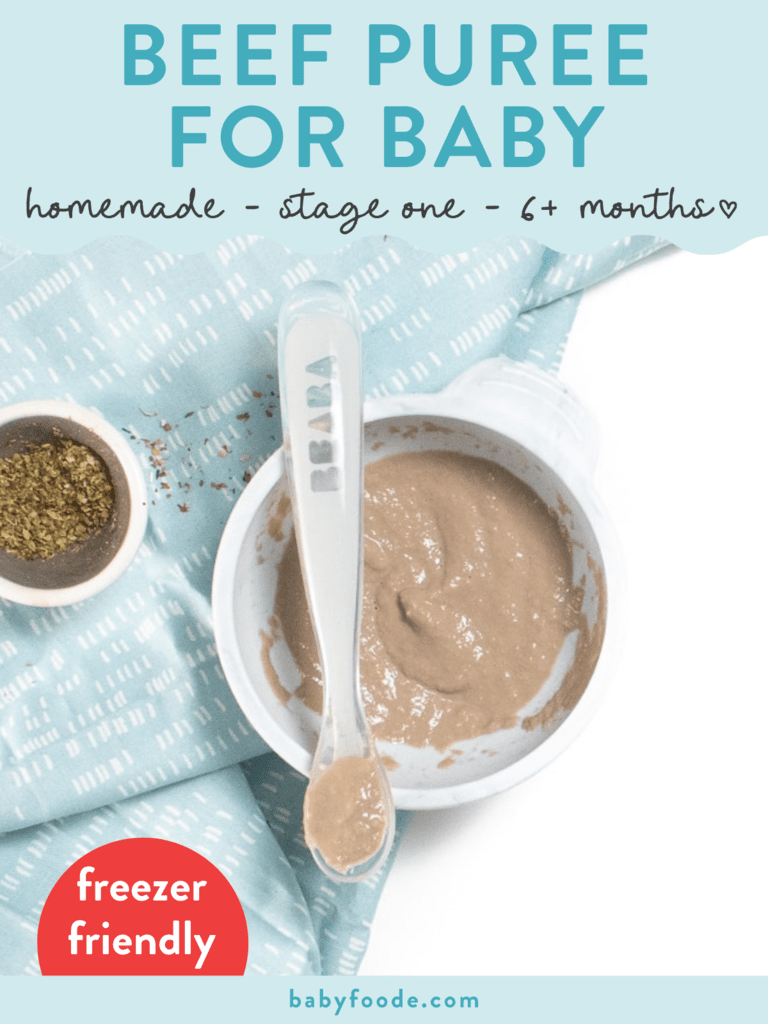
Medically reviewed and co-written by Jamie Johnson, Registered Dietitian Nutritionist (RDN), and Lauren Braaten, Pediatric Occupational Therapist (OT).
Beef Baby Food
Beef, it’s what’s for baby’s dinner! Beef puree, that is. 😉
This beef puree is loaded with so many great nutrients that your baby needs in order to thrive – protein, iron, calcium and folate.
And while it may seem counter-intuitive and perhaps weird (or at least it did to me), beef puree 🥩 is a great first food for your baby.
Just because it’s a nutrient-dense puree doesn’t mean your baby needs bowls upon bowls of it. Since beef puree has a somewhat intense flavor, a few spoonfuls added to your baby’s favorite veggie or fruit puree should be enough.
Is it your first time making homemade baby food? If you answered yes, then I suggest you start this journey by reading my in-depth Guide on How to Make Homemade Baby Food. The detailed article goes over all the essential information such as the best cooking tools to have on hand, safe storage, knowing when your baby is ready for solids, introducing purees, making the best first foods for baby, and more! You can also check out my best-selling cookbook for even more information and recipes.
Beef Puree Video
Watch this video to see how easy it is to make your baby homemade Beef Puree!
Reasons to Love this Beef Puree
- simple yet flavorful
- packed with protein
- great to add to any other fruit or veggie puree that baby loves
- baby food for 4-6 months and up
- stage 1 baby food
- freezer-friendly
- homemade
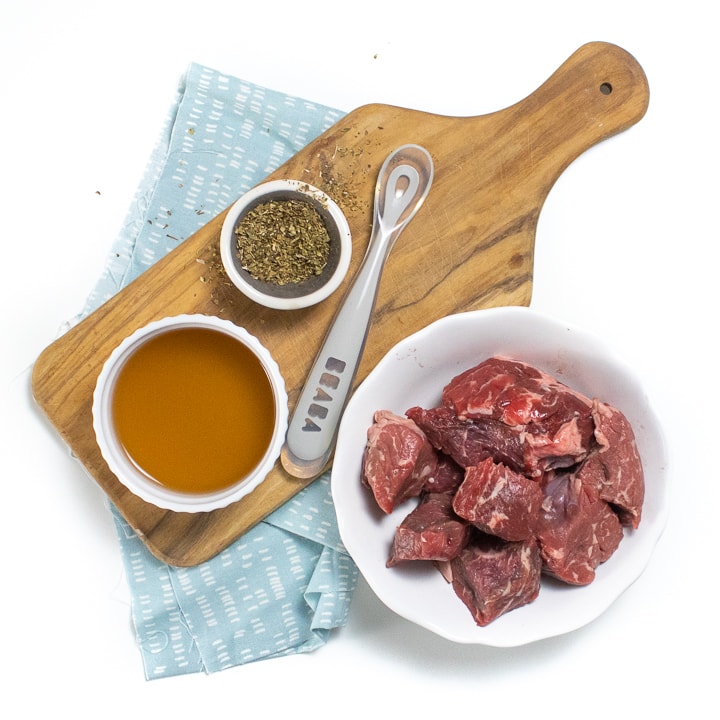
Ingredients
Make sure to read the recipe card below for full ingredients and instructions!
- Beef: Since beef is the star of the show in this puree, we are going to start with a good piece of meat. We are going to use 8oz of chuck stew meat or cubed sirloin beef. You can also easily scale up this recipe if you want more than 12 ounces of baby food.
- Broth: To get that rich, deep beef flavor, we will cook our beef in beef broth. I recommend using a low-sodium, sodium-free, or free-range beef bone broth for this recipe. You can also use any of those variations above with a vegetable broth as well. If you don’t have any of those on hand, you can use water.
- Oregano: We are adding dried oregano to give the puree a little more complex taste. This can easily be omitted if you prefer or you can substitute in dried parsley, basil, rosemary, thyme or cilantro.
Grass-Fed Beef: I recommend using grass-fed beef for this recipe, if possible. Grass-fed beef will have more healthy fats, more free Omega-3 fatty acids (healthy fats), vitamins A, E, and B as well as more antioxidants.
Health Benefits of Beef
- Protein: Beef is an excellent source of protein, which is essential for proper growth and development of all organ systems and maintaining and repairing tissues. It is considered a complete protein, meaning it has all of the amino acids that are needed to make protein.
- Iron: Beef is a good source of iron, needed for making red blood cells, neurodevelopment and preventing iron deficiency anemia, and zinc, needed for growth and development and supporting the immune system.
- B12: Beef is also high in B12, which is essential for brain development and healthy red blood cells.
- Choline: can also be found in beef, which is also important for brain growth and development.


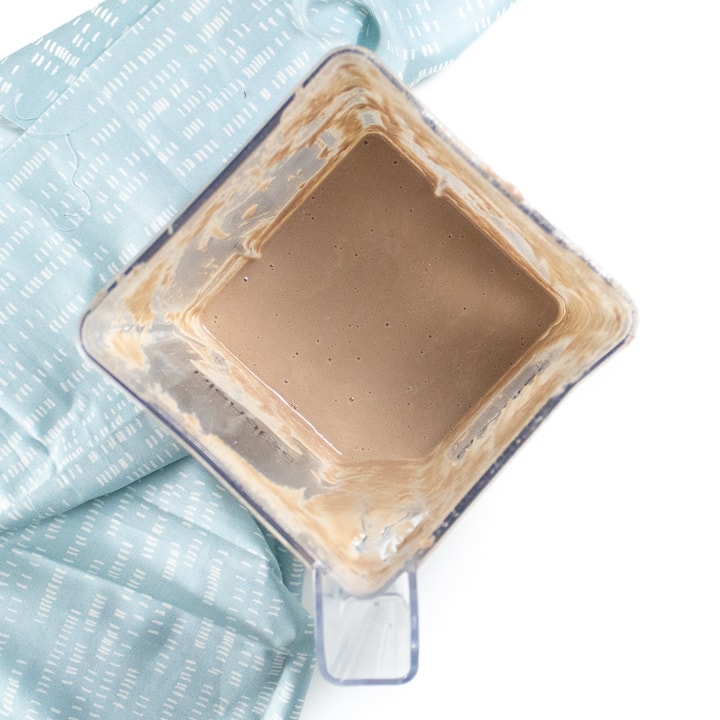

Step-by-Step Instructions
- Boil: In a medium saucepan, bring the cubed beef, broth, and oregano to a boil over medium heat.
- Simmer: Turn the heat down to low and cover the saucepan. Simmer for 15-20 minutes or until the beef is just cooked through. Let it cool slightly.
- Puree: Using a slotted spoon, transfer the beef to a blender or food processor and puree until you reach your desired consistency, adding broth in 1/4 cup increments if needed.
- Eat: Serve to your baby plain or added into another puree.
- Freeze: Store a small portion in the fridge and freeze the rest for another meal.
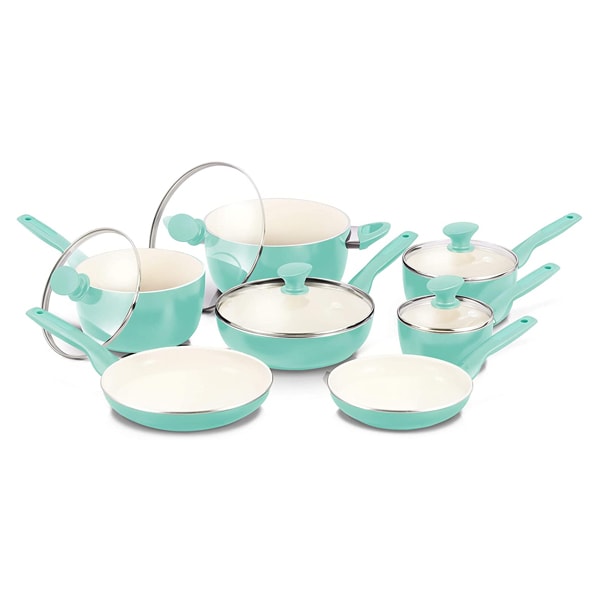

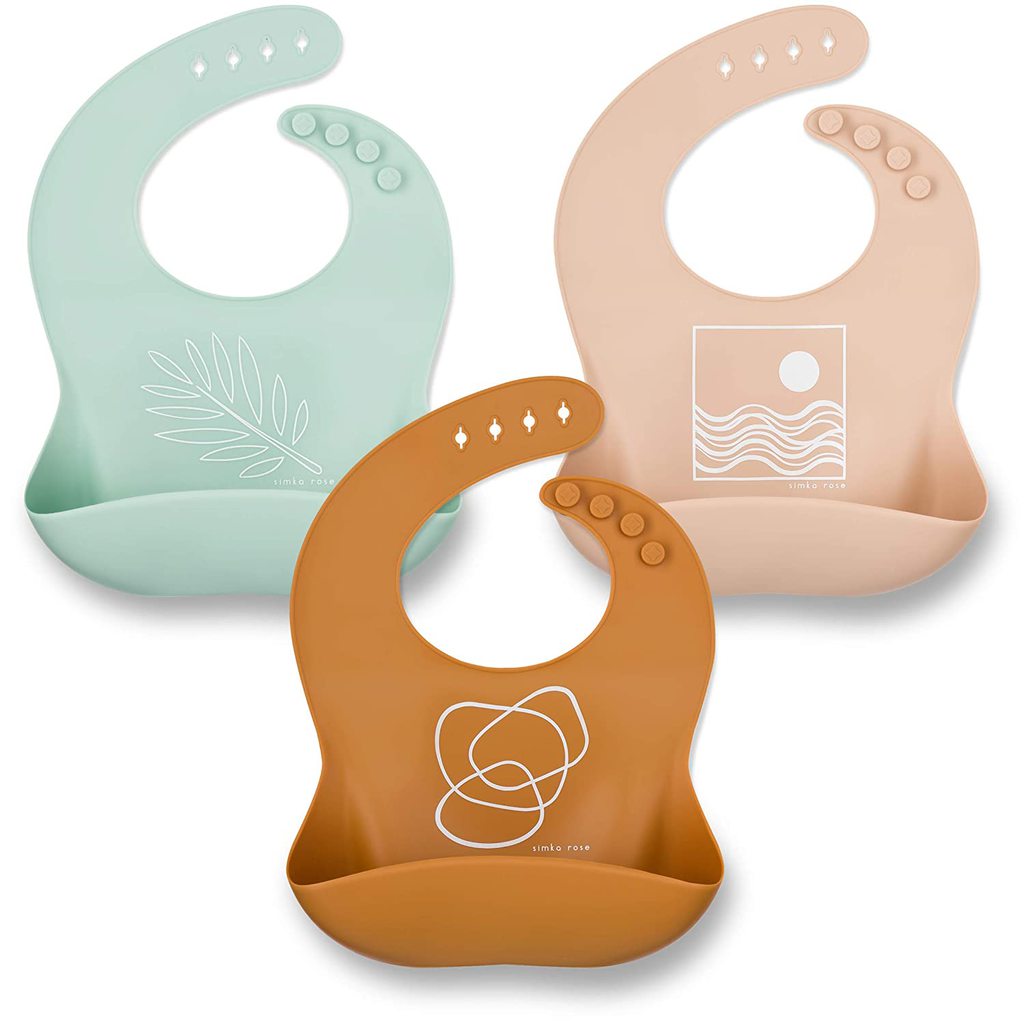
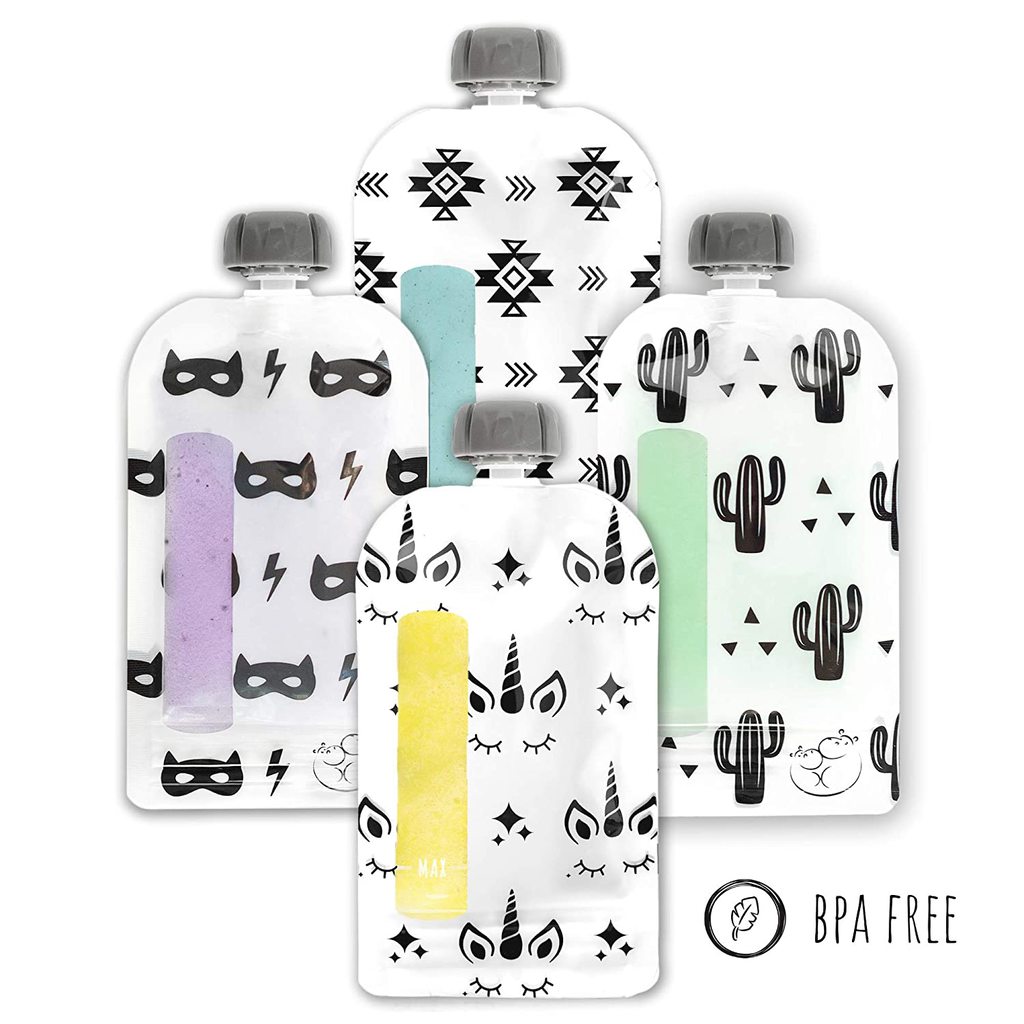
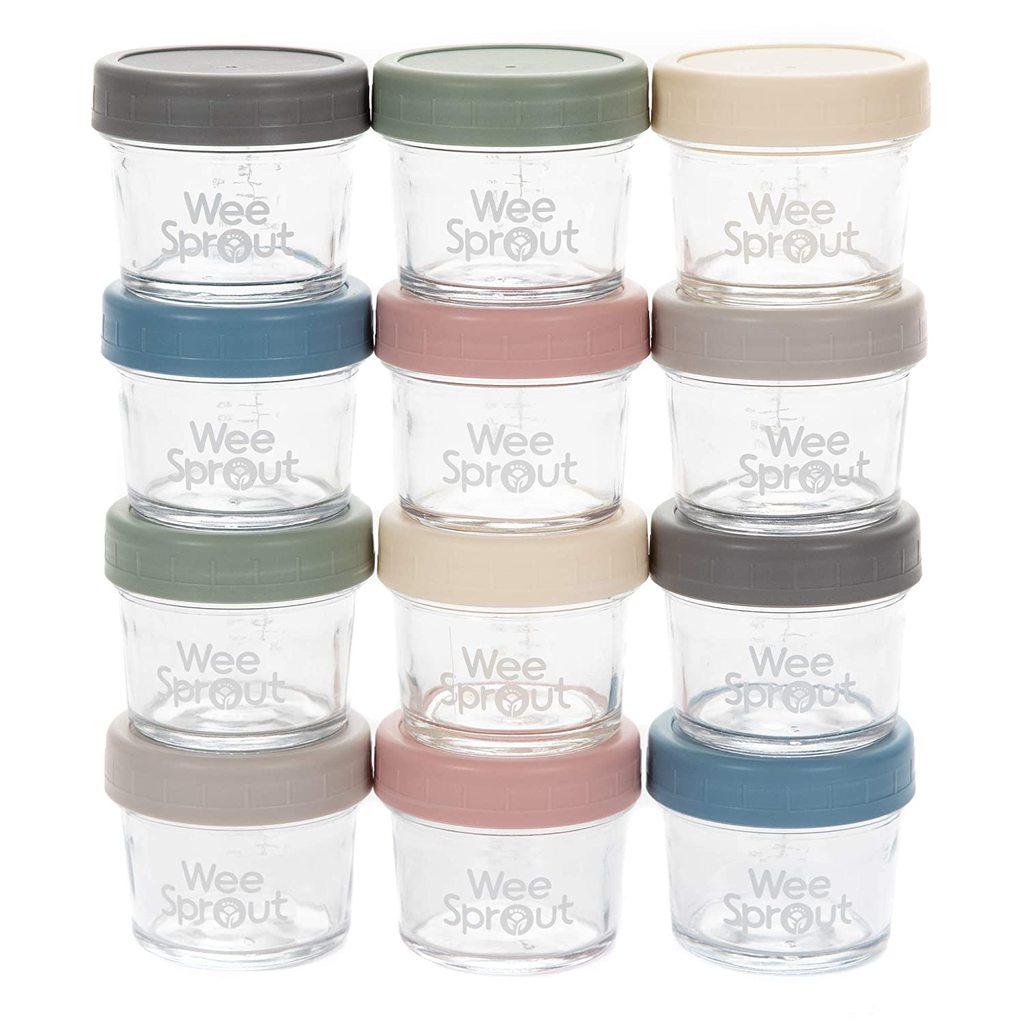
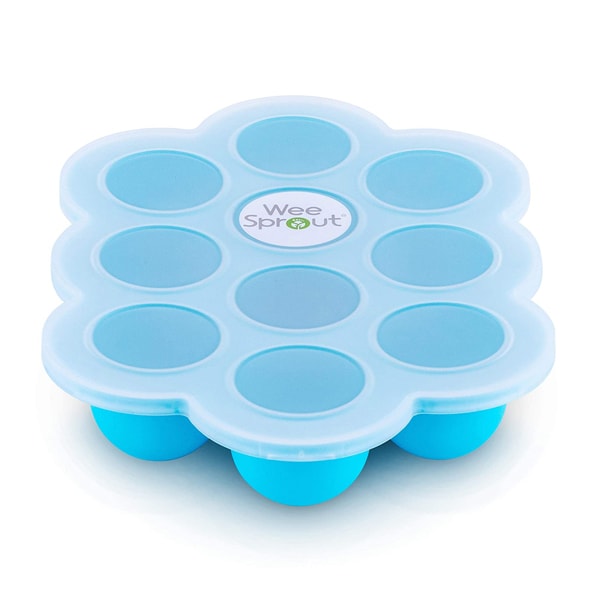
Tools Needed
These tools will make it a lot easier for you to make this healthy Beef Puree. For more of my favorite kitchen tools make sure to check out my shop.
- Saucepans
- Blender or Food Processor
- Freezer Tray
- Storage Containers for Fridge
- Stasher Bag
- bib with catch pocket
- Saucepans

Frequently Asked Questions
Babies can have beef as one of their first foods. When a baby can start on solids is determined by their own rate of development, which generally comes between 4-6 months of age. Some of the developmental milestones babies need to reach in order to start solids include: if your baby has solid control of their head and neck, if your baby has doubled in weight, and if your baby is reaching for or opening their mouth when you eat (see my guide here). Before you start your baby on purees, you should consult with your pediatrician to make sure your child is developmentally ready.
Can beef be baby’s first food?
Yes, beef can 100% be baby’s first food if you want it to be. It is recommended to wait to introduce the top eight allergen foods to baby once a few other well tolerated foods have been introduced, but otherwise foods can be introduced in any order so choose whatever you are most excited for baby to have.
Is beef a common allergen for baby?
No, beef is not a common allergen, however, as with any food, start with a small portion and be aware of any signs that might be an allergic reaction after introducing it.
Does beef cause constipation for babies?
No, beef itself is not known to cause constipation in babies, however it won’t really help with constipation either since it lacks fiber. If baby is eating too much meat, it could replace fiber-rich foods, which could cause constipation.
How to Store Beef Puree
Refridgerator
You can store this puree in an airtight container in the fridge for up to 3 days.
Freezer
This puree can be frozen for up to 2 months.
- Spoon puree into a freezer storage container. Do not overfill.
- Place the lid on the storage container or cover with a piece of saran wrap, and label with the date and recipe name.
- Place the tray into the freezer and let it freeze completely — preferably overnight.
- Pop out the baby food cubes and place them in a ziplock baggie or stasher bag. Don’t forget to relabel the baggie or stasher bag for future reference.
Need more information on how to store your baby foods? Head over to my Best Baby Food Storage Containers – Plus 6 Tips on Freezing and Thawing post!
Label Tip: Don’t forget to label your purees before you place them in the fridge or freezer with the name of the puree and the date you made it. Take it from me; by the end of the week, you will completely forget what is in your freezer and how long it’s been there. 😉

Great Beef Combination Purees
While this beef baby food is great by itself, it can be a little intense for some babies. I recommend mixing it into one of your baby’s favorite purees as an introduction to the rich taste of beef. Here are some great purees to mix with the beef puree:
PUREE FEEDING TIPS
- Follow your baby’s lead – when feeding purees from a spoon, sometimes there’s a tendency to keep offering bites past the point of your baby being full. Always follow your baby’s cues for when they are done eating. Turning away from the spoon, closing her mouth, or pushing food away are all signs that your baby is finished with the meal.
- Try adding a little seasoning or spice to purees – babies like flavor! Or consider changing the temperature of purees from time to time, to slightly warmed or slightly chilled. Varying these aspects adds to the sensory experience!
- Throwing spoons is a common phase that all babies go through at one point or another. One of the best ways to handle spoon throwing is to ignore it and keep feeding your baby as usual (with an extra spoon you already have at the table). If your baby ends up also throwing back up spoons #2 AND #3, simply encourage your baby to eat with their hands until they appear to be finished with the meal. ***Give baby plenty of opportunities to practice putting items in and taking items out of containers outside of mealtimes.
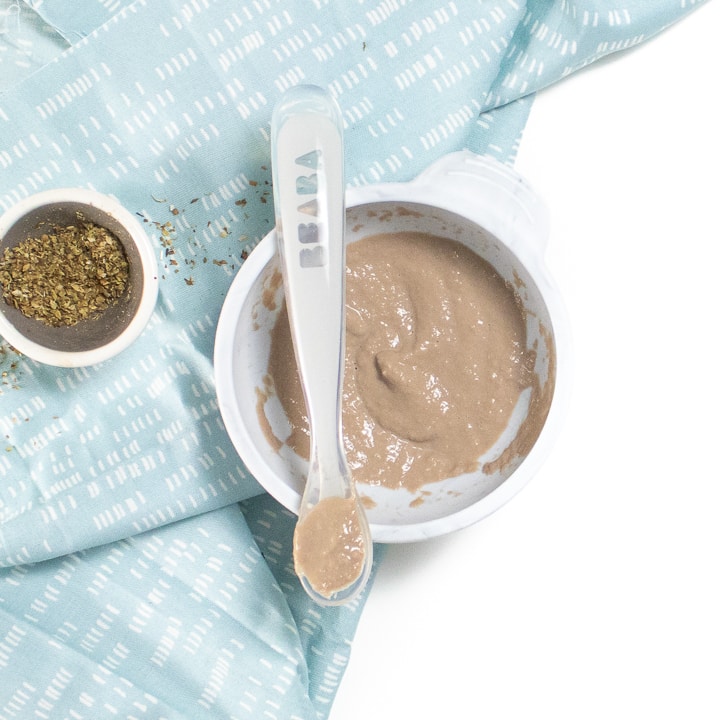
Recipe Tips
- Use a Slotted Spoon: When transferring the cooked beef from the saucepan to the blender, make sure to use a slotted spoon so you don’t add too much broth into the puree from the start. You only want to add broth if needed while blending. I had to add a 1/4 cup of broth to the blender while I was pureeing this beef.
- Reheat Gently: If you are freezing some of this beef puree, reheat it in 20-second intervals. You don’t want to recook the beef.
Recipe

Get the recipe: Basic Beef Baby Food
Ingredients
- 8 ounce beef chuck stew meat, or cubed sirloin beef
- 2 cups beef or vegetable broth, low or no sodium
- 1 tsp dried oregano
Instructions
- Boil: In a medium saucepan, bring beef, broth and oregano to a boil over medium heat. Turn to low and simmer for 15-20 minutes or until beef is cooked all the way through. Let cool slightly.
- Transfer: Using a slotted spoon, transfer the beef to a blender or food processor, reserve broth.
- Puree: starting on low and working your way up to high-speed, puree the beef until you reach your desired consistency, adding in broth in 1/4 cup increments if needed. I had to add in just 1/4 cup of broth to get the consistency seen in this photo.
- Eat: serve to baby plain or added into another puree.
- Freeze: store a small portion in the fridge and freeze the rest for another meal.
Notes
Did you make this recipe?
Tag @babyfoode on Instagram and hashtag it #babyfoode!

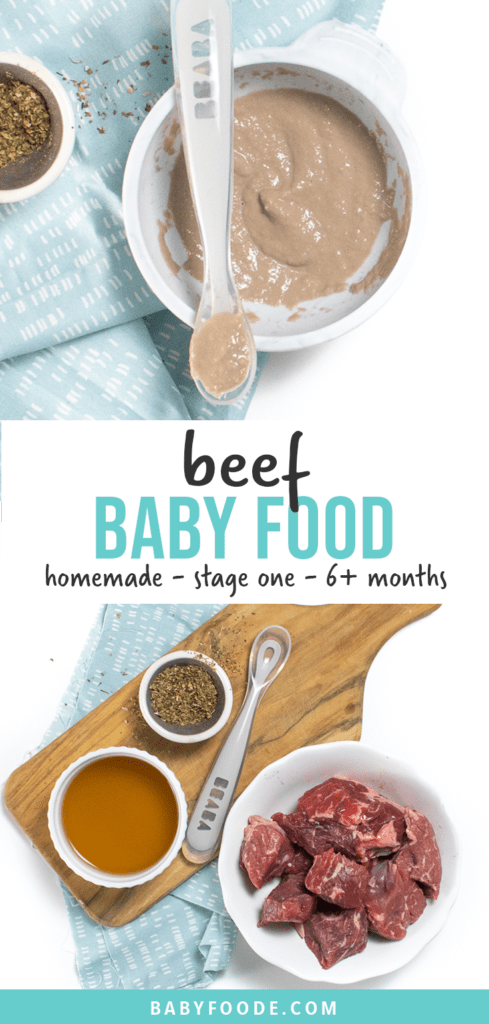
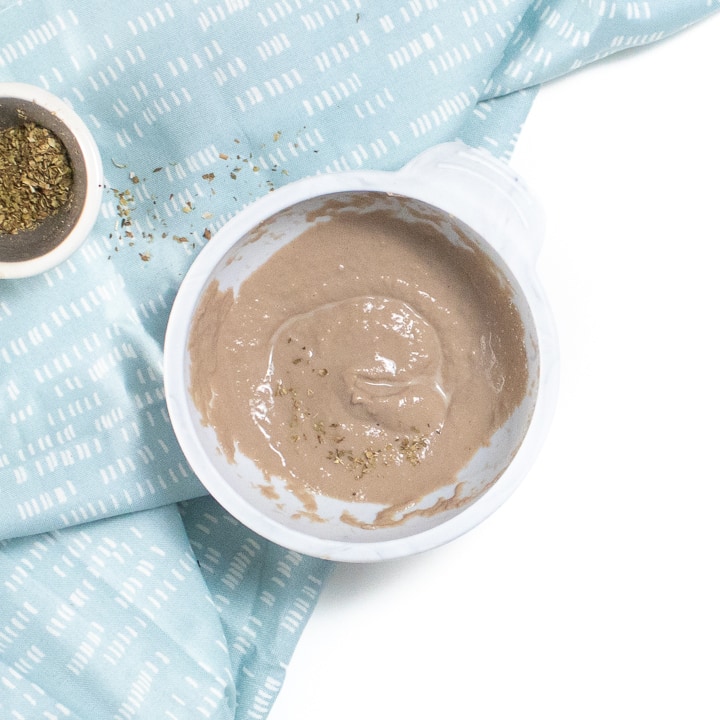

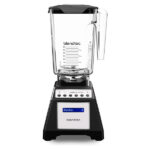
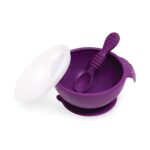
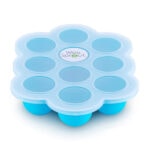
59 Comments on “Basic Beef Baby Food”
I just want to tell you how much I love your website and recipes! I made this beef puree for my 9 month old daughter and froze it in cubes. Today I thawed two cubes of the beef along with two cubes of sweet potato/coconut milk/curry paste and it was a hit! I tried it too and it was delicious! Even stirred in a little fresh pureed mango at the end for a little sweetness. I love making all the purees and then mixing and matching the proteins/fruits/and veggies. Wonderful!
Hello Allison,
So glad you both liked the puree!!!! I love that you are mixing and matching your own combos! Let me know which ones you come up with that are winners!!
xo, Michele
I just want to tell you how much I love your website and recipes! I made this beef puree for my 9 month old daughter and froze it in cubes. Today I thawed two cubes of the beef along with two cubes of sweet potato/coconut milk/curry paste and it was a hit! I tried it too and it was delicious! Even stirred in a little fresh pureed mango at the end for a little sweetness. I love making all the purees and then mixing and matching the proteins/fruits/and veggies. Wonderful!
Hello Allison,
So glad you both liked the puree!!!! I love that you are mixing and matching your own combos! Let me know which ones you come up with that are winners!!
xo, Michele
Hello!! I love your website!!! Who knew baby food could be so exciting?! I have some grass fed ground beef and was wondering if we could use that for the beef purée? It’s grocery day, so if not that’s fine but thought I’d ask. Thank you for sharing all your knowledge!
Hello Dani,
I haven’t tried this recipe with ground beef, but I have made a beef puree using ground beef that is somewhat similar. In a medium skillet brown the meat with a spice until it is just cooked but not actually browned yet. Then pour in the broth (maybe 2 cups) to cover the meat, bring to a boil and then reduce heat to a simmer. Simmer for 5-10 minutes. Let cool and puree. I would add maybe half the cooking broth to the blender and then add more if needed. Hope that helps!
Let me know if that works!!
Thanks for reading!
xo, Michele
Hello!! I love your website!!! Who knew baby food could be so exciting?! I have some grass fed ground beef and was wondering if we could use that for the beef purée? It’s grocery day, so if not that’s fine but thought I’d ask. Thank you for sharing all your knowledge!
Hello Dani,
I haven’t tried this recipe with ground beef, but I have made a beef puree using ground beef that is somewhat similar. In a medium skillet brown the meat with a spice until it is just cooked but not actually browned yet. Then pour in the broth (maybe 2 cups) to cover the meat, bring to a boil and then reduce heat to a simmer. Simmer for 5-10 minutes. Let cool and puree. I would add maybe half the cooking broth to the blender and then add more if needed. Hope that helps!
Let me know if that works!!
Thanks for reading!
xo, Michele
I just discovered this website 5 minutes ago, and I can tell already that this will help me SO much! Thank you so much for taking the time and figuring out all these recipes for us moms! Keep them coming!! 🙂
So glad you found us!!! Make sure to let us know what you make, and how they like it!
xo, Michele
I just discovered this website 5 minutes ago, and I can tell already that this will help me SO much! Thank you so much for taking the time and figuring out all these recipes for us moms! Keep them coming!! 🙂
So glad you found us!!! Make sure to let us know what you make, and how they like it!
xo, Michele
I love your recipes! Have you ever tried lamb purée. I can’t find any recipe online. Can you please give me an idea about cooking time and which herbs would blend well with it? Thank you.
You know, I haven’t tried to make any lamb puree. Maybe give these a whirl –
https://woolworthsbabyandtoddlerclub.com.au/recipe/bubs-lamb-veggies-and-rice/
https://www.first1000days.ie/recipe/lamb-and-sweet-potato-puree/
I love your recipes! Have you ever tried lamb purée. I can’t find any recipe online. Can you please give me an idea about cooking time and which herbs would blend well with it? Thank you.
You know, I haven’t tried to make any lamb puree. Maybe give these a whirl –
https://woolworthsbabyandtoddlerclub.com.au/recipe/bubs-lamb-veggies-and-rice/
https://www.first1000days.ie/recipe/lamb-and-sweet-potato-puree/
Hi, I love all of your recipe ideas. I tried this one but added too much liquid! Have you got any suggestions of how to thicken the puree? Thanks x
You could add in a another veggie puree that is really thick or add in a little oat cereal to the beef puree.
Hi, I love all of your recipe ideas. I tried this one but added too much liquid! Have you got any suggestions of how to thicken the puree? Thanks x
You could add in a another veggie puree that is really thick or add in a little oat cereal to the beef puree.
Hello just wondering if I cook the beef first before putting in the broth? Thank you
No, you add the raw beef to the broth and then cook it.
Hello! Thank you so much for sharing such amazing recipes. Love them! I was wondering if I can use water instead of beef broth? What do you think?
With love from Kuwait 😊
Yes, you can. It will have a more mild beef taste.
Do you think it would be ok to use chicken broth for beef? I have fresh chicken broth available but no beef broth.
Yes, chicken broth would totally work.
Could you use grilled steak ?
I haven’t tried using grilled steak, I would worry that it would be too tough to puree. But you could try it with a small portion.
I just found your website this morning! My baby tried all the pureed fruits and vegetables and I knew he was ready for meat as I put a few grains of rice in his carrots last night and he took it like a champ. Didnt know where to start with the meat but I made your chicken this morning and am making your beef now. I didn’t have oregano so I put in some rosemary.
Thanks for the recipes! I can’t wait to try chicken. I know he’ll love it.
Wow, thanks for the recipes. I was actually looking for the ingredients in Beechnut meats when I came upon your site. Im going to try the meat recipe for my cat. He loves Gerber meats but they have recently added cornstarch which gives him urinary problems. The ice cube size is the perfect portion size for him too. You think of everything! Thanks
I never thought about giving pureed meat to a dog – great idea!
I was looking for liquid treats for my cat and I had an epiphany… This Is great! We’ll be making this shortly for our training sessions (without the herbs and using water instead of broth of course)
Thank you so much for the recipe!
So, you say cook until just done, does this mean brown all the way through or light pink? With steak there are so many versions of “done”
Thank you…
Great point. I would cook until the beef is brown all the way through.
Amazing web-site, thanks for all the work you are doing for us!
I have some questions on boiling a meat.
1. When water turns a boiling point you get a lot of froth, should you take it out with a spoon?
2 20 minutes of boiling will definitely cook a meat, but is it too much time?
Thank you
I haven’t gotten any froth while boiling. You will want to start at a boil and then reduce the heat to a low simmer. Maybe that is the difference? I have found that 20 minutes on a low simmer is the ideal time to cook the beef without over cooking it. Your beef may cook faster if you have it at a higher temp, so check it at 15 minutes. Hope that helps.
I have an Autistic son with textural issues with food. Trying to make a bolognaise failed as the beef ended up being gritty after blending… I hadn’t thought of boiling, so my beef was too dry. This is a game changer. Thank you for posting – you might have just solved a massive stress!
Would love to know if this recipe helped the beef be tender enough for your son.
Thank you. This really helps
Love your website! As a FTM learning to make baby food for my little guy, this is super helpful. Excited to make this but I’m wondering if you can make this beef purée with ground beef?
Welcome! So glad to have you here! You can make this with ground beef! I would saute the ground beef in a skilled over medium heat, drain any excess fat and then add in 1-2 cups of sodium-free broth and let simmer for 10 minutes. Then you can transfer that to a blender and puree, adding water or more broth if needed. Hope this helps!
Does anyone else have the issue with it not blending into a perfectly smooth purée?no matter how long I blend it in the food processor, it’s not smooth.
So sorry this isn’t working for you. Mine always comes out as the pictures or video show (I don’t modify those in any way). How big are your chunks? I did suggest to another reader to try adding in some sweet potato to give the beef puree a smoother base – you can try this recipe if you want.
I am having the same problem. I use a ninja food processor and used sirloin but no matter how many times I purée it, it just turns into pasty ground beef. I use water to cook the meat and the same water to blend but it just wouldn’t turn into purée. I wonder if it has to do with the food processor or it has to be blended with broth.
I love your recipes and website!! Thank you!
But I some reason I can’t seem to get this one right, I can’t get it smooth! It still has small soft pieces of beef through it, I am not sure if this is ok to give to baby! No matter how much I puree in the food processor or how much liquid I add 🙁 any tips? Thanks!
So sorry this one isn’t working for you. How big are your “small” pieces of beef? The pictures and video is the consistency I get every time I make this recipe, Does it look like that? Another thing you could try is to blend it with sweet potato or try this recipe (the sweet potato may give the beef more base for the puree).
I loved this recipe so much when I had my son that now I’m using again for my daughter!!
So happy to hear that both your little ones like this recipe:)
Hello, I’m looking for healthy recipes for our twins!
First want to say your recipes are fabulous! Love making homemade food for my little guy.
This beef recipe requires a high power blender. I first tried with my Hamilton beach hand blender and I just couldn’t get a smooth enough consistency plus, there were tough chunks left in the purée. When I transferred it to my Oster blender, that finally did the trick. Just think this might be good to note considering beef tends to be more tough than fruits and veggies 😉
Thank you so much for your kind words! So glad you are here. Yes, a high-power blender is helpful with this recipe if you want to make a smooth puree. However, a chunky beef puree would be great for 9+ month puree.
I made this tonight and I have Blendes it for ages trying to get the lumps of meat put of it what can I do
Oh no. How big are the lumps and what kinds of blender are you using? I’ve never had this problem before. Did you cook according to the directions?
Great receipe. Real simple and straightforward, my 9 month old boy loves it and we have started incorporating venison and different cuts of beef in with other wrinkles like whole butter, and different stocks. He is healthy, thriving and has a great appetite.
So happy to hear that your little one is loving this recipe. Love that you are substituting in version and other cuts of beef and it’s still turning out great!
I made this today and it was a hit! Thanks for the great recipe.
So glad this beef puree was a hit! Thank you for the review:)
My 7-month-old loved this. I’ve had trouble in the past when my older two children were babies with making beef purée but this was so easy and had good texture to it.
Hi Stacey! So happy to hear it worked out well for you! xo, Michele